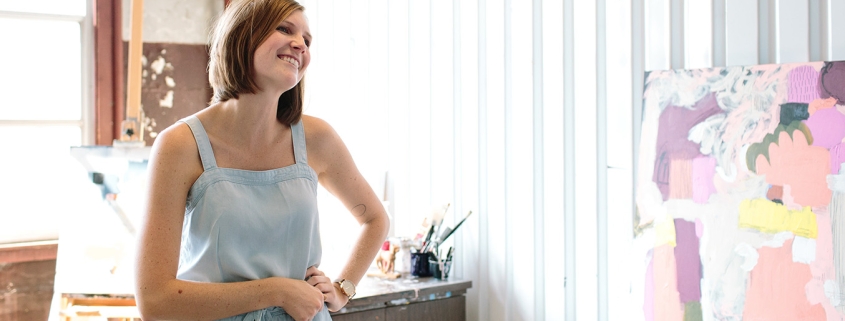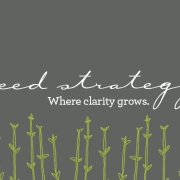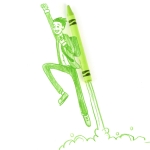The Art of Marketing: 3 Lessons Marketers Can Learn From Abstract Painting
Painting is my passion, turned hobby, turned side hustle. Before my life at Seed Strategy, I spent over a year as a full time “sabbaticalist”—taking time to be vulnerable, try new things, travel to new places—all to influence my career path forward. During this time, I officially became an artist. Although I had dabbled in artistic ventures for years, and even studied Studio Art (in addition to Marketing) during undergrad, I never once before called myself an artist.
As an artist, I gave myself the license to break the rules. I shed some of my more formal artistic training and decided to start painting what I felt, not just what I saw. My work evolved from representational figures into abstracted forms, expressing point-in-time emotions. All inspired by moments spent in nature and the exploration of boundaries—finding peace by desperately holding onto some, while releasing others.
And while this is all very liberating, abstract painting isn’t all fluff and freedom. In fact, my days painting are spent constantly making decisions. Plotting my strategy. Training myself to trust my gut. Figuring out when to be bold and when to pull pack and be more restrained.
Sounds an awful lot like what marketers do, doesn’t it?
The more I paint, the more parallels I notice between the worlds of art and marketing. With that in mind, I set out to capture some of the most impactful lessons from my art studio that have also helped me become a better marketer.
1. Attack the Fear of the Blank Canvas by “Ruining it” From the Beginning
For some artists, the blank canvas is the most daunting part of the process. For me, it used be downright paralyzing. Because I so desperately wanted everything to be perfect, simply getting started was often the hardest part of any piece.
Turns out, if you jump in with intentional recklessness, it’s pretty easy to break the paralysis of perfectionism. I’ve found that the blank canvas becomes a lot less daunting when you start by “messing it up.” I now make a massive stroke or literally pour paint on that pristine white canvas before making any controlled marks. The canvas instantly becomes less precious and delicate. That first move may become integral to the final product, or it may get buried below future layers of paint, but either way it gets things going and builds the momentum I need to begin my journey.
Likewise, when facing a challenge in the world of brand strategy, that first step is often the hardest. But, just like I’ve learned in my artwork, the best way to start is often with an uninhibited move—like a bold premise or hypothesis. It doesn’t have to be polished or perfect. It could very well turn out to be disproved, but things have a way of progressing once you set an initial point to ground the rest of the journey.
2. Embrace Curiosity and Let Every Stroke Influence the Next
Each mark I paint represents the knowledge and emotion I possess in that very moment. Throughout the process I continue to agree or disagree with each previous mark, acting with intention and passion in the moment. I don’t know where I’ll turn next until I get there, but I continue to ask questions, listen, and trust that through the process of painting, the path forward will reveal itself. My favorite paintings are always guided by this looping cycle of curiosity and observation until the piece is both conceptually and visually resolved.
Similarly, the best work of a marketer—be it innovation, positioning, brand architecture, or anything in between—often stems from an unparalleled curiosity. We marketers are full to the brim with questions, especially when it comes to the consumer. We desire to know what makes our consumer tick. What are their motivations? What are their needs? Their attitudes? Their shopping behaviors? And the best of us actually listen and observe any chance we have to interact with our target consumers.
Not only is consumer research part of the J-O-B, it is an absolute gift. And when we listen, objectively, and take consumer insights at face value, they have a meaningful impact and power to transform the outcome of the project. What we thought was going to be a right turn becomes a giant U-turn and then a sharp, well-timed left—all thanks to a fresh consumer insight, and our ability to listen, adjust and react.
3. Know When to Use a Flat Wash Brush and When to go With a Small Detail Brush
There’s a time for the big picture and there’s a time for the precise details. Abstract expressive painting is far from linear, but my process still includes some guardrails. Early in the process of a new painting, I lay the ground layers with broad strokes and thin washes to help bring to life the big picture before I fine tune with control and detail. I continue building layers by toggling back and forth between big, broad gestural washes and smaller movements of texture, shape and fine line. As I meander through the painting process, it is necessary to do this dance between fine tuning and big bold strokes that dictate the final composition of the piece—all while physically moving up close to the painting, and then stepping back to take it all in.
When it comes to working in the ever-changing and fast-paced world of marketing, one of the greatest skills is agility, and in this case, the ability to toggle between the 30,000 foot big picture, then down in the trenches, and then back up again.
When working across multifunctional teams, matrix organizations, or layers of hierarchy, it’s important to know when to focus on the microscopic details—to execute, to manage the project details, to analyze the data, and to draw insights into action. But, there are also moments when it’s essential to zoom out and look at the big picture, to influence the strategy and vision, to align key leadership and stakeholders.
Being able to see both the micro and macro, while also seamlessly transitioning between the two, sets us apart as both doers, and thought leaders.
What have you learned from your passions and hobbies that you’ve been able to apply to your professional life? I’d love to hear about them—please comment below.
Erin Mahorney is a Strategist at Seed Strategy where she combines her artistic intuition with extensive marketing experience to help clients create masterpieces of innovation.
Connect with us! Follow Seed Strategy on LinkedIn, Twitter, Facebook and Instagram.
Photography courtesy of Cassandra Zetta and Five Dots Cincinnati.










Great article, Erin!